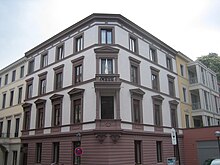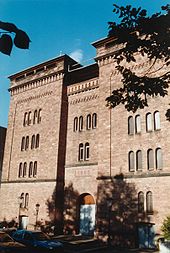Residential construction Mainz
| Residential construction Mainz | |
|---|---|
| legal form | Company with limited liability |
| founding | 1917 |
| Seat | Mainz , Germany |
| management | Franz Ringhoffer and Thomas Will (managing directors), Dr. Eckart Lensch (Chairman of the Supervisory Board) |
| Number of employees | 172 |
| Website | www.wohnbau-mainz.de/ |
The housing Mainz is the municipal housing company of the city of Mainz . With 10,500 residential units, it is the largest provider of housing in the state capital.
history
The housing Mainz in 1917 nor during the First World War under Mayor Karl Göttelmann founded. She built her first apartments on the right bank of the Rhine after the end of the war. There, the Kostheim settlement was built in a short time with large green areas and small terraced houses modeled on the garden city flow, in which contemporary two-room apartments with kitchen-living room, toilet and bathroom gave families a new home.
By the beginning of the Second World War, the company owned 1,256 apartments on both sides of the Rhine, many of which were destroyed in the hail of bombs of the last days of the war . Housing construction in Mainz only got going again in the early 1950s , but after that it made rapid progress. Large residential areas emerged on the outskirts of the city, and Wohnbau Mainz was involved in the urban development of Mainz in almost all areas.
In 2009 a significant financial bottleneck was discovered in the company. As a result of mismanagement and aggravated by the financial crisis , Wohnbau Mainz had problems obtaining new loans for loans that were due to expire. The heavily indebted company was on the brink of collapse, but the city of Mainz agreed to provide a guarantee of 300 million euros. This made it possible to obtain new loans and initiate restructuring. The supervisory and service directorate in Trier, which is subject to approval, approved the guarantee, but demanded that material costs in the new company be significantly reduced and the workforce significantly reduced. The latter was realized. The debt was reduced by the sale of 2,800 apartments in the right bank of the Rhine to the state capital Wiesbaden before the re-establishment. The city of Wiesbaden then withdrew from the company at the end of 2009, as did the Landesbank Baden-Württemberg.
The "new" housing
On December 1, 2009, the new housing group started work. The company now focused on apartment rental. Other branches of business such as the operation of restaurants, the property development business or the development of commercial properties were given up. The around 10,500 existing apartments in the Mainz city area were transferred to the new subsidiary WB Wohnraum Mainz GmbH & Co. KG with the organizational change. A second subsidiary, WB Gewerbeimmobilien Mainz GmbH & Co. KG, took over around 300 commercial units that were intended for sale. The third company in the group, WB Services GmbH, takes care of the technical support of the apartments and residential complexes with its craftsmen and caretakers. As of January 1, 2019, Wohnbau Mainz dissolved the two subsidiaries WB Wohnraum Mainz GmbH & Co. KG and WB Gewerbeimmobilien Mainz GmbH & Co. KG and transferred them back to Wohnbau Mainz GmbH. Today the company is economically successful again and is the largest and cheapest housing provider in Mainz. The shareholders are the city of Mainz (89.8%) and Rio Energieektiven GmbH und Co. KG (10.2%).
Objects
In addition to apartments, houses and commercial properties in all parts of the city, Wohnbau Mainz maintains a number of senior citizens' housing complexes such as the Franz-Stein-Haus (named after the former mayor of Mainz, Franz Stein ), the An der Krimm residential complex in Mainz-Gonsenheim and the Weifert-Janz- House on Kirsteinstrasse in Mainz-Oberstadt . In 2005, in Mainz-Neustadt, the company also opened a multi-generational housing project that has won several awards. Under the motto "At home in Mainz - live together carefree", further residential projects are also being created that combine independent living, security of supply and living neighborhood. So far there have been three such projects in the districts of Hartenberg-Münchfeld, Mombach and Ebersheim. More are being planned.
Projects
- Conversion area "Old Artillery Barracks" Gonsenheim with approx. 1.7 ha.
- Dreikönigshof on the Kästrich in the former Schöfferhof / Dreikönigshof brewery with partial preservation of the facades from 1889
- Housing project "At the Bruchspitze" between Mainz-Mombach and Mainz-Gonsenheim
- Residential quarter "Pfarrer-Brantzen-Straße" in the residential area "Am Großen Sand", a conversion area between Mombach and Gonsenheim
- "At home in Mainz - live together carefree"
For two projects (Dreikönigshof and nine courtyard houses in Mainz-Hechtsheim), Wohnbau Mainz received a state award for architecture and housing construction from the State of Rhineland-Palatinate in 2007. Multi-generational living in Mainz Neustadt was recognized. For the residential complex "Am Cavalier Holstein" (at home in Mainz, 2016) the company received the 2018 State Prize for Architecture and Housing.
Urban development
To renovate the old town , the company has expanded the Gutenberg Museum , built and renovated the "Frankfurter Hof", as well as building and modernizing houses and residential projects in Gaustraße , Fischergasse, Augustinergasse and -gässchen, Weißliliengasse, Heringsbrunnengasse and Fischtorstraße contributed. In addition, Wohnbau Mainz has partially contributed to the purchase, renovation and redesign of historic buildings such as the " Provision Magazine ", the redesign of the historic market houses (architect and designer: Massimiliano Fuksas ), and the conversion of the former Etex wholesale department store to the "Wohnpark am Kupferberg" The listed facades from the years between 1860 and 1880 in Breidenbacher-Straße made a decisive contribution to the cityscape. In 2009, the construction of a new office and commercial building including the parking garage "Am Bahnhof Mainz Römisches Theater ", the former Südbahnhof, was completed.
Shareholder structure
As of December 1, 2009, Wohnbau had a housing stock of 10,500 rental apartments in which around 35,000 citizens live and rented 299 commercial units. From this date, the shareholders are the city of Mainz as the main shareholder with 89.8% stake and RioEnergieektiven GmbH & Co. KG with 10.2%. The supervisory board with its chairman, deputy Dr. Eckart Lensch, reflects the shareholder structure.
Web links
Individual evidence
- ↑ On the assessment as mismanagement: Frankfurter Allgemeine Zeitung of November 25, 2009 under “Capri trip in sight”: “The municipal housing company was almost ruined by mismanagement and risky credit and financial transactions.” Allgemeine Zeitung Mainz on the same day under "minus 180 million": "... There are also provisions for proceedings due to construction defects and condominiums and a double-digit million amount due to further mismanagement".
- ↑ "Babbedeckelfassaden" must be in FAZ
Coordinates: 50 ° 0 ′ 2.5 ″ N , 8 ° 14 ′ 52.7 ″ E




